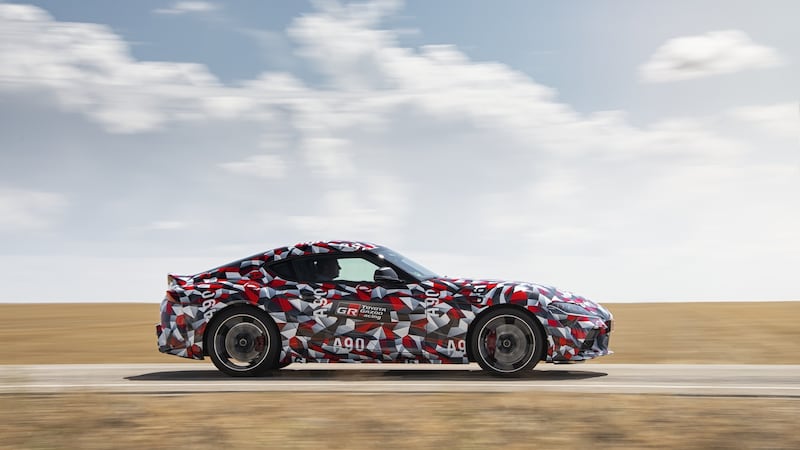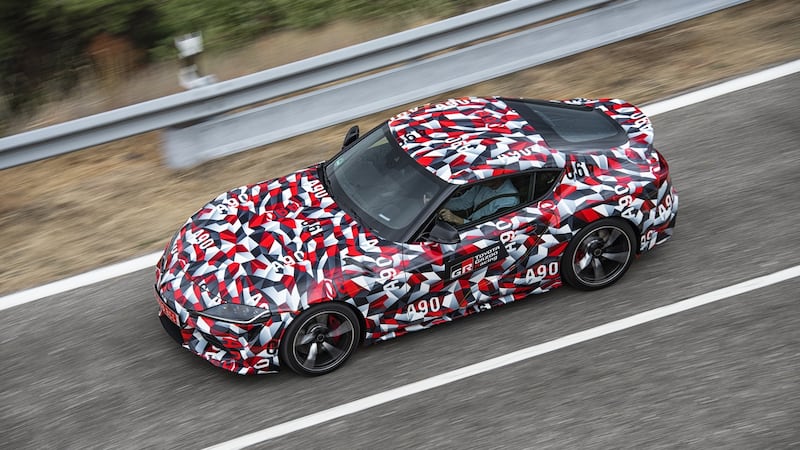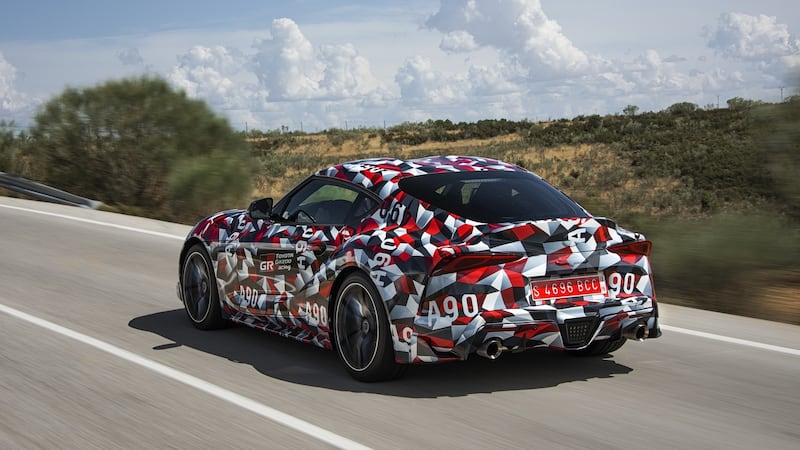It seems like forever. 22 years ago, I was essaying my first venture into the world of motoring writing, spending a few weeks as a work experience wonk at Autocar magazine in London. On my last day, taking pity, the deputy editor took me out for a spin in one of the mag's long-term test cars, and for a brief few moments, let me take the wheel. That car was an A80 Toyota Supra, and it blew my mind. The acceleration from its twin-turbo straight-six 2JZ engine was astonishing, especially to a kid who'd only previously driven his dad's 1.6-litre Ford Sierra.
A quarter century on, that was the first and last Supra I ever drove. In the intervening years, Toyota retreated from making truly sporty cars (the Supra died in the late 1990s, followed all too soon after by the Celica and the MR2) as it focused on high-volume, high-profit cars that may have lacked for excitement, but which turned Toyota into a global manufacturing colossus.
That changes now. The Supra’s back. My youth my have dissipated in the years since I last drove one, but the Supra has remained the same – a two-seat, rear-drive, coupe with a turbocharged straight-six engine, and a chassis that has been specifically tuned for fun over outright performance.
You'll probably note that Toyota does not make a straight-six engine, and that's because the Supra's engine isn't actually a Toyota unit at all. Although it's controlled by Toyota software, this is actually a BMW engine, and the Supra's chassis, electrical architecture, and cabin all share a great deal with the newly-launched BMW Z4. The two cars were conceived as a joint project, and were initially supposed to be as closely related as the Toyota GT86 coupe and the Subaru BRZ, but as the Supra's chief engineer told us, that changed early on.
Pure sports car
Tetsuya Tada is a legend in his own laptime, an engineer specifically trusted by car-mad Toyota boss Akio Toyoda to bring sportiness and a sense of fun back to the Toyota range. He told The Irish Times that, when it came to sharing the project with BMW, the two cars actually diverged early on. "We tried to do the same as what we did with the GT86," said Tada.

“But it was impossible. The two cars were becoming so different. We took the collaborative approach, but then we stepped back and thought, ‘let’s decide what we want to make’. We wanted to make a pure sports car and have not yielded on that. So the separation began at an early stage, and in fact we have an agreement with BMW not to ask each other too much about each other’s cars.”
Tada is totally open about the fact that the Supra's powerplant is still, to all intents and purposes, a BMW engine. When The Irish Times asked him if a BMW unit would be reliable enough to meet Toyota's standards of longevity, he said: "We're confident about the reliability, It's under the normal warranty, so that should be sufficient on the reliability front." At this point, Tada pauses and, ever painfully honest, admits that: "I will say it was difficult getting there. We had to have many discussions with the warranty team . . . "
The Supra we were given to test drive is, even all this time since the end of production of its predecessor, still not quite finished. It’s a late engineering prototype, swathed in dazzling camouflage tape, and with its interior hidden behind sheets of heavy felt cloth. In fact, even though Toyota has been teasing us with concepts, styling models, disguised prototypes, and video game versions of the new Supra, production still won’t start until the spring of 2019, with the first deliveries set to start next summer.
For those keen enough, Toyota is setting up a Supra 900 Club, for the first 900 customers who put down their deposits when the order book opens in October. Their deliveries will be prioritised.
What will they be getting? Well, as if the anticipation of the wait wasn't bad enough, just before we drove it, Tada described the car to us as a "Porsche Killer" and that's about as hefty a gauntlet as can be thrown down.
While we still can't quite see the styling under the camo, it's clear that the Supra hasn't strayed especially far from the looks of the dramatic FT-1 concept car from 2014. The Supra is low, swept-back, with a dramatic double-bubble roofline and a very sharply chopped-off tail. It's also quite dainty. Tada had the Porsche 718 Cayman dead in his crosshairs when he designed this car, so the Supra is only 4.3-metres long, and a slim-hipped 1.86-metres wide. Final tech specs are still under wraps, but it should weigh a couple of sandwiches under 1,500kg.
BMW-ish
The cabin, when we furtively peer behind the felt covers, looks very BMW. While the main instrument binnacle and the centre touchscreen are separate items here, compared with the conjoined versions inside the new Z4, the whole layout of the car, the buttons, the column stalks, the steering wheel, all look and feel very BMW-ish. Toyota claims that the Supra’s cabin is, in fact, entirely bespoke, but unless there’s going to be a lot of changes between now and the start of production, we’re not so sure. There’s even an iDrive-style clickwheel controller for the infotainment system.
The cabin is snug, but comfy and there’s enough space for even a tall driver to get thoroughly settled. The straight-six engine fires smoothly when you press a small silver button behind the wheel, the eight-speed automatic gearbox slots silently into first, and we’re off.
That engine should have in the region of 340hp and about 450Nm of torque. Again, Toyota’s lips are still a little sealed when it comes to the Supra’s vital statistics, but it should certainly be brisk. The same engine in the BMW Z4 propels it to 100km/h in just 4.6secs, and we’d guess that the Supra will be fractionally faster than that.

It sure feels faster. The engine is initially buttery smooth and very refined, but as we select Sports mode and start looking for the redline, its character changed noticeably. First of all, it becomes a lot louder, and truly musical. In fact, as you get past 5,000rpm the noise coming off it is distinctly like that of an old-school Porsche flat-six. Tada told us how disappointed he was in the sound quality of the Porsche Cayman’s new turbo flat-four engine, so consider this his revenge. Better still, there’s no artificial engine note. The Supra will eventually get a system that amplifies engine noises through the stereo (in part so that it can get around strict new drive-by noise rules) but our cars didn’t have it fitted, so the sound was pure, and unfiltered.
Whatever about the noise, the speed is truly impressive. The Supra has been designed around maximum fun, rather than maximum performance, but it gathers speed at a ferocious rate. Even at the upper limits of the rev range, that engine never seems to run out of breath, and the ZF gearbox is remarkably perceptive about when you need a gear, and which gear you need. It did occasionally shunt a change, but that could be down to some final software calibration. Thankfully, with all that performance, the brakes are well and truly up to the task. Four-pot Brembo calipers working on big, steel, discs even a session on a blazing hot Jarama race track, just outside Madrid, didn’t see them wilt.
Tada has truly worked his magic on the way the Supra drives, though. At first, the car seems almost a touch too remote and refined. It’s hugely comfortable on the road, which is just not what you’d expect. Yes, the suspension is firm (although during development the front suspension was actually softened a little in the search for more grip, and less understeer) but it’s pliant enough to soothe away the scars of heat-damaged roads, and even takes sharp speed bumps in its stride. Aside from a slight touch of tyre roar on coarse surfaces, you could easily and happily drive this Supra from one side of the continent to t’other.
Superbly agile
Which had us, for a moment, worried that it would be too remote, to uncommunicative. Thankfully, it’s not. The steering is, perhaps, a little over-light, and we would like to have a bit more true feedback from the front tyres, but aside from that the Supra is a true savage for corners. Those tight dimensions, the low centre of gravity, and a clever electronic differential that does as much to help the steering and turn-in as it does to find more rear-end traction mean that the Supra feels like a low-slung, longer, Mini in the corners.

It is superbly agile and responsive, and if the steering is a bit short on feel, then it’s certainly tall when it comes to precision and speed. Even fumbling our braking into a few tighter corners, or trying to take Jarama’s Turn One hairpin way too fast, the Supra found the grip we needed, turned in where we wanted it to, and was never anything less than biddable and hugely, enormously, enjoyable.
A Porsche Killer, then? Well, possibly. Perhaps a Porsche Sparring Partner would be a better phrase, because the Supra actually feels very Porsche-like in its responses and its setup. That same sense of solidity underpinning the agility, rather as if you took the sharp chassis responses of the Cayman and mixed them with the refinement and soundtrack of the 911. Not a bad mix at all, that.
There is much we don’t know yet. We don’t know the full performance figures. We don’t know if there will be a manual gearbox (Tada would like to do one but it might be too expensive to do, or at least to do properly). We don’t know, albeit we strongly suspect, if there will be four-cylinder or hybrid versions. We, of course, don’t know how much it will cost but the likelihood is that if you look at the Porsche Cayman GTS’ circa €95,000 figure then you’ll probably not be too far out.
Of only minority interest, then? Nope, not a bit. The last Supra became an icon of both high-performance cars, and the might of the Japanese motor industry, and I suspect that this new one might just do the same job. In and of itself, it’s a pure, proper sports car – one that’s easy and engaging to drive, but which has properly ferocious performance once you dip below the surface. It’s also emblematic of a Toyota which has changed out of all proportion. Now, volume and profit aren’t the be-all and end-all. Tada and Toyoda want you to love the brand as much as you appreciate its reliability, and cars such as the Supra are key to that. I’ve waited 22 years to get back here, back to the driver’s seat of a Supra. It was worth the wait.
The Lowdown: Toyota Supra
Price: Circa €90,000 as tested (TBC).
Power: 340hp (est).
Torque: 450Nm (est).
0-100km/h: 4.5sec (est).
Top speed: 250km/h (est).
Claimed economy: n/a.
CO2 emissions: n/a.
Motor tax: n/a.
Verdict: Truly exceptional.
Our rating: 5/5












